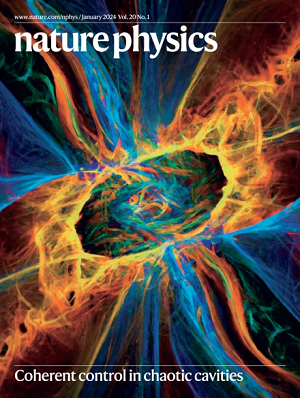Coherent coupling and non-destructive measurement of trapped-ion mechanical oscillators
IF 17.6
1区 物理与天体物理
Q1 PHYSICS, MULTIDISCIPLINARY
引用次数: 0
Abstract
Precise quantum control and measurement of several harmonic oscillators, such as the modes of the electromagnetic field in a cavity or of mechanical motion, are key for their use as quantum platforms. The motional modes of trapped ions can be individually controlled and have good coherence properties. However, achieving high-fidelity two-mode operations and non-destructive measurements of the motional state has been challenging. Here we demonstrate the coherent exchange of single motional quanta between spectrally separated harmonic motional modes of a trapped-ion crystal. The timing, strength, and phase of the coupling are controlled through an oscillating electric potential with suitable spatial variation. Coupling rates that are much larger than decoherence rates enable demonstrations of high-fidelity quantum state transfer and beam-splitter operations, entanglement of motional modes, and Hong–Ou–Mandel-type interference. Additionally, we use the motional coupling to enable repeated non-destructive projective measurement of a trapped-ion motional state. Our work enhances the suitability of trapped-ion motion for continuous-variable quantum computing and error correction and may provide opportunities to improve the performance of motional cooling and motion-mediated entangling interactions. A lack of non-destructive measurements and difficulty in tuning direct coupling between motional modes limits quantum information processing with trapped ions. Both features have now been achieved in an ion crystal using oscillating electric fields.


困离子机械振荡器的相干耦合和非破坏性测量
对几种谐波振荡器(如空腔中的电磁场模式或机械运动模式)进行精确的量子控制和测量,是将它们用作量子平台的关键。被困离子的运动模式可以单独控制,并具有良好的相干性。然而,实现高保真双模式操作和运动状态的非破坏性测量一直是个挑战。在这里,我们展示了在受困离子晶体频谱分离的谐波运动模式之间进行单个运动量子的相干交换。耦合的时间、强度和相位是通过具有适当空间变化的振荡电势来控制的。由于耦合率远远大于退相干率,因此可以演示高保真量子态转移和分束器操作、运动模式的纠缠以及虹欧-曼德尔型干涉。此外,我们还利用运动耦合实现了对被困离子运动态的重复非破坏性投射测量。我们的工作提高了困离子运动在连续可变量子计算和纠错方面的适用性,并为改善运动冷却和运动介导的纠缠相互作用的性能提供了机会。
本文章由计算机程序翻译,如有差异,请以英文原文为准。
求助全文
约1分钟内获得全文
求助全文
来源期刊

Nature Physics
物理-物理:综合
CiteScore
30.40
自引率
2.00%
发文量
349
审稿时长
4-8 weeks
期刊介绍:
Nature Physics is dedicated to publishing top-tier original research in physics with a fair and rigorous review process. It provides high visibility and access to a broad readership, maintaining high standards in copy editing and production, ensuring rapid publication, and maintaining independence from academic societies and other vested interests.
The journal presents two main research paper formats: Letters and Articles. Alongside primary research, Nature Physics serves as a central source for valuable information within the physics community through Review Articles, News & Views, Research Highlights covering crucial developments across the physics literature, Commentaries, Book Reviews, and Correspondence.
 求助内容:
求助内容: 应助结果提醒方式:
应助结果提醒方式:


